Eleonora Manca stands out in the national and international video art panorama for her extremely original stylistic signature, which places her outside of any systematic collocation. A combination of theatre, dance, philosophy and gnosis, mixed by a refined use of software. The result is a long videographic journey that unfolds in chapters and subchapters of a single cosmogonic narrative that illustrates existence as an exploration of the body/otherness limit, soul and sensorial metamorphosis, elegance of the spirit expressed through the body.
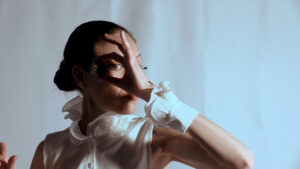
Eleonora Manca, L’ora del coprifuoco, 2021. Video still. Courtesy the artist
Piero Deggiovanni: I would like to start with your book Il sognante risveglio alla visione (The dreamy awakening to the vision) on the relationship between theater and archetypes. It seems to me that even today your work maintains a close link between body and archai, as if the body itself were a semblance and the theater the place of the aesthetic action of archetypes: that famous mundus imaginalis so dear to Henry Corbin.
Eleonora Manca: It is an ancient book. First of all, because I wrote it eighteen years ago, then because it addresses the theme of the dream-theatre dyad through a rarely adopted phenomenological approach. At the time I was painting and had started a project based exclusively on the use of white color entitled Rêverie. Those paintings still exist and this “dreamy awakening to vision” still persists. I decided to start the volume with a question by Henry Corbin (orientalist philosopher and historian of religions) who invited to reflect on how much and how the mystical experience tended to strip itself of images, to renounce all representations of forms and figures. It was inevitable to compare this question (the answer to which is, by God, still unknown to me) to Giuseppe Desa da Copertino who adored the yellowed silhouette, left on the wall, from the frame of a painting of the Madonna. Years later I read a phrase by Andy Warhol that I added to my phrasebook: «My favorite sculpture is a wall with a hole that frames the space on the other side»; it too traced the path further. If it was true that theater (even as architecturally constructed in ancient Greece) invited us to explore the skenè (the modern stage) as a door to descend to Hades, and that the concept of skia (shadow) is already an archetype in itself, for me it had to be equally true that writing, making art could not be exhausted in the final outcome, but rather we had to be part of a flow in which every creative process leads to experiencing a kind of ecstasy during which one is a stranger in one’s own body, because the body – in those enlightened moments – participates in the existence of forms that have always been present. These forms are the archetype, the collective unconscious. Creating is already a magical act in itself, perceiving oneself within creation, knowing how to see something that is only apparently not there or that goes beyond mysticism. For this reason, the concept of mundus imaginalis remains an extension of thought and action. Because it is precisely the vision during each imaginatio agens that leads to the emergence of what our psyche – in dream/sleeping states – has already created unconsciously. It is therefore the Myth, or the archetype, that operates. For this reason, I consider this writing as an unconscious journey into my imagination that has allowed me to restore, from time to time, the designated places of a narrative that I intend to leave in progress because it is devoted to metamorphosis.
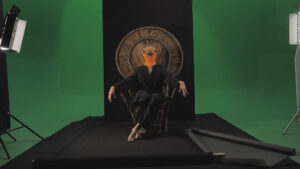
Eleonora Manca, the lucid dream of the last poets, 2023. Video still. Courtesy the artist
Do you think you are an inhabitant or an explorer of this “intermediate world”?
I think I keep both potentials open. Essentially because I consider myself a hybrid being, both physically and intellectually. And then because I have always had the attitude of a keen observer but choosing to remain on the ridge. A bit like a Two-faced Janus. Living without exploring would be extremely boring and inconclusive, equally exploring without stopping to live resembles a narcissistic neurosis that would prevent any wound from being overcome. I see myself perched high up. That I look a little down and a little with my nose turned up. Even though I have a well-rooted principle of reality, I know perfectly well how to stop in what I call “my rooms”, amid whose walls I lose time and find myself wandering in spaces that every time I am amazed to have inside. Well, I still manage to be amazed, I consider this a great gift: I am still hungry, and this leads me to procure the necessary food. I am still curious, this allows me to experience boredom as a life-giving moment. And above all I still know how to desire, and this is opposed to lack. Sometimes I inhabit the space as if I felt I had belonged there for incalculable eons, other times I feel like an explorer coming from who knows where and who knows with what feathers that has to learn new codes, new ways of welcoming, new measures and excesses. There is this little girl inside me who wants to play (and we know how very serious playing is), question, explore, move with a dance step and I hold her hand and often get to know her. She is inspiring.
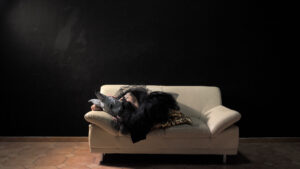
Eleonora Manca, the lucid dream of the last poets, 2023. Video still. Courtesy the artist
In many interviews you have highlighted an element that distinguishes your art compared to other more political or expressionist uses of the body: that is, the overcoming of the Body Art aesthetics and other forms of conceptual art.
Body has its own grammar which – like any other communication system – is constantly evolving. Through its movements it knows how to express an infinite range of meanings and signifiers. The work carried out by the pioneers of Body Art – between the 60s and 70s of the last century – is today exclusively historical data, to be studied, explored, but certainly not to be repeated in the same ways, because the historical and cultural context has changed. With respect to these important outcomes which in their time were truly disruptive and absolutely political, I place myself ahead or behind. Body Art and Performance Art’s aesthetic is naturally in my database since it is essential, but today it is an art form that I consider part of the History of Art. And since the body is an archetype, as well as the artist’s body, the challenge is to say without repeating. My work certainly deals with the body, with its claim to be as it is and not a sexualized stereotype or a target of body-shaming, but through the use of the symbol and a language which – I hope – is timeless and not stigmatizable into genres or sub-genres. Basically, the artist has multiple genres to which he belongs; they should be travelers without constraints. From this point of view, talking about the body by reawakening Antigone or Joan of Arc or Rosa Parks is the same thing. The body freed from the identity card becomes legible in every era. Therefore, I do not want to display it as an excuse to talk about something that can be ascribed to a theme, but (eventually) in order to be off topic, in transit. No (longer) exploited by media language, no longer a symptom of colonial epistemology, but rather a cartographic sign to revolutionize syntax, semiotics. Let the body speak through metamorphosis without a start or expiration date.
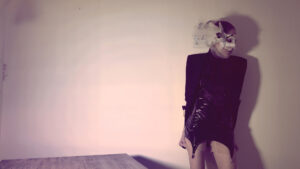
Eleonora Manca, back an hour and how to wear it, 2024. Video still. Courtesy the artist
I believe that this overcoming also depends on the dance use of gestures that enrich the performance with ritual aspects.
In my works the performative gestures are multiple, starting from the fact that I am in the action, simultaneously the one who records the action and the one who, ultimately, takes care of editing the video or creating photographic micro-narratives. I never talk about self-portrait, because I do not believe in it and because that body “kidnapped” by the chosen medium is no longer that body, simply because it is impossible to happen twice. There is no reality, there is no presumption of truth except in the context of representation. Post-production is essential to overcome the limits of physicality and access knowledge of the image itself and, at the same time, is an exercise in prolonging the performative action. Giving action back its choreutic/symbolic character means, once again, not giving it age, but continuous archetypal rebirths. The study of the gesture allows me, during the editing phase, to clearly see the direction I intend to give to the entire action. It is like the work of a seamstress: I know exactly when to cut a clip. I also have learned not to rush: I can stay on one movement even for days. This recovery of time (absolutely new to me) increasingly resembles a dance between me and the computer. And it is above all this phase of post-production that has the flavor of a ritual. A satisfying stupor inevitably sets in. And this too is new. For years I self-educated myself in the romantic vision that making art meant tearing yourself apart, losing blood and other clichés as a young Werther. Now, if my dear and atavistic Sturm und Drang does not sense a conspicuous margin of pleasure, it does not even carry out a project, it abandons it. And since haste is the enemy of pleasure, I can now stay on a job for many months, if not even years.
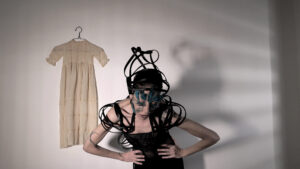
Eleonora Manca, back an hour and how to wear it, 2024. Video still. Courtesy the artist
We could define your works as “synecdoches”. Let’s talk about the symbolic use you make of the body: how do you manage to make themes, that undoubtedly have a biographical basis, universal?
In my works the biographical basis is only a starting from the end, that is, from a sort of nostalgia for presence – which (to me) is always elusive as a whole. For this reason, talking about synecdoche leads to deciphering that indispensable nucleus that can be glimpsed in all of my projects (this can also be seen from the body that is almost never filmed in its entirety). I struggle to identify a tout court diary/biographical component because I am faithful to two thoughts that I now consider my poles of action, namely Carmelo Bene’s: «There are no personal facts if told» and Gina Pane’s reflection on the concept that we usually start from a singular “I” that immediately it becomes plural. However, it is in the symbol and in the archetype that, inevitably, there is the encounter with one’s own memory. It is as if there were a subject spied on by the “I”, from ancient scenes and at the same time projected towards a beyond to come. I use the body, my body, because it is an archetype and instrument as precarious as it is of resistance, especially in the face of inevitable metamorphoses. It is therefore the basis for the paradigm of new poetic geographies or for reconstructing lost languages. However, the map is hardly the entire territory and therefore the symbol becomes the banner of gesture and action. Once again it is the work on the body theorized by many theatrical outcomes that emerges. I think of Meyerhold’s Biomechanics, of Gordon Craig’s puppet actor, of the inexorable broken, defective, inadequate and insufficient gesture theorized by Carmelo Bene; that constant discomfort of going not from A to B, but of the pause of the fragment from A to A1, when the action is annihilated in the illusion of completion and remains forbidden and impossible to complete. A continuous de-constructing to build oneself and vice versa. And then there is stasis as a counterpoint to movement. The broken diaphragm. The body that remains on the innocence of the ridge. And suddenly the organic abstraction where the artist’s body is just a device, the prosthetic necessity useful for not retreating from any possible form. This is (for me and for my work) creating a symbolic body, a source of those meanings that contain all aspects of human nature.
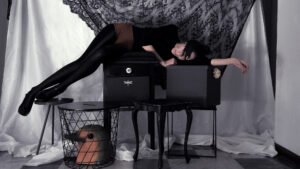
Eleonora Manca, back an hour and how to wear it, 2024. Video still. Courtesy the artist
Performance is actually your language of choice. Do you believe the use of software makes the ritual sense of gestures more effective and fits perfectly with one of your main themes, such as metamorphosis?
We were talking about the post-production phase similar to the work of a seamstress. But, with respect to the performative action, which is reaffirmed through the choice of using various software, I would also speak of a similarity with the weavers and the perpetual stitching. I am reminded of that mythical story left to us by Maria Lai about the Janas, the island fairies born from the god who, renouncing the divine dimension, symbolizes the first man who dreams. He used to lay down with a beehive whose inhabitants, the bees, one day transform from his fingers into a tribe of very small female deities. The ancestral presences that gave breath and creation to Sardinia, the Janas precisely, will live for a few millennia waiting for the women who would arrive on the island, building gold looms and subsequently teaching women the art of spinning and weaving. From this construction, faithful to the order of a cosmogonic rhythm, the poet will then be born: a concentration of man, woman and divinity. Since we are talking about archetypes, annexing the rituality of the artistic gesture to that of dreaming, both a man-machine encounter and a narrative to be entrusted to time, calls the artisanal suggestion of working with the hands in its value as a key to open all those doors that symbolize the threshold; which is always located at the borders that delimit the territory of the divine from human nature. At the same time, the chosen rhythm of the work, first internal and then external, becomes a process (the process is already metamorphic in itself) to ensure that the unseen will be said. Likewise, entering into dialogue with the machine and its software means understanding how to establish a breath that oxygenates equally. And every time it changes, it varies. Support the time of metamorphosis.
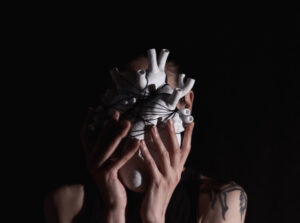
Eleonora Manca, Piccolo archivio del sollievo, 2021. Video still. Courtesy the artist
Many of your works seem inspired by deities such as Hecate and chthonic spirits. Do you think evoking this dark side of wisdom can describe an alternative way to the stereotypes linked to identity that characterize much videoart today?
The metamorphic condition is already cryptic in itself because it does not provide for a systemic and predictable regulation. The secret kept by the underworld deities about the meaning of human existence, the dark side of wisdom, as you say, is actually never dark, but only hidden. Beyond that threshold lies the hiding place of the treasure of wisdom. We have ruined the gods, we have replaced them, we have therefore lost the sacred and pagan sense of the cycles of death and rebirth which, however, are also archetypes.
In some of your works the dressing element plays an important role. Can you describe the symbolic relationship between body and garment?
When I was a child, we had a huge basket full of discarded clothes at home. I could play and do whatever I wanted with them. My passion for playing dress-up, experimenting with new identities, transforming to bring out unexplored sides of the self was born in those years. I believe, therefore, that I have always been very curious about what a dress could do beyond simply covering the body. As Paul B. Preciado says: «There are those who dress to be naked and those who undress to remain dressed». Now that the season of essential study of the naked body has probably come to an end, the need to experiment with clothes has grown again for quite some time. I create totemic animals with feathers, armor with old crinolines. I sew new gender-free identity possibilities onto my skin.

Eleonora Manca, Vedersi visti, 2019. Digital print. Courtesy the artist
You recently wrote a book together with Alessandro Amaducci: Fashion Film. Nuove visioni della moda. Do you believe that fashion needs a symbolic base as a cultural added value to increase the market?
I would like it to clear away certain stereotypes when we quickly talk about fashion: one thing is fashion and another is the fashion system. Fashion, in itself, like all art, is always a litmus test of the socio-anthropological context in which it operates. For example, the Punk movement was the daily newspaper of crucial years. The minimalist movement of the 90s introduced alternative, bruising and sometimes even deathly visions (let’s not forget that those years were the ones, for example, of Joel Peter Witkin or Grunge) and which could no longer be represented by haute-couture. Upon closer inspection, every revolution has had its own clothes of identification as an interpretative form of the contingent. There would be many examples, but what interests me about fashion is its artistic, innovative and performative declination. Therefore, the fashion I follow is already symbolic in itself as it already has that cultural added value. There are creative directors who embrace artistic projects whose intellectual side is very lively and experimental. I find the fact that some fashion houses finance projects that go far beyond sewing a dress to send to a fashion show an added value.
Your latest video production completed a noetic and aesthetic journey that lasted at least ten years. Incredibly we find themes expressed in your book on theater and archetypes, but with a disconcerting compositional accuracy: we find gnosis and fashion harmoniously fused in the role of sacred, shamanic dressing, and in some cases, reaching an interspecies dialogue as identification with one’s guide animal. Soul, animus, body, united in a stunning way by very current but ancestral outfits. Do you think you have completed your metamorphosis?
I hope I will never complete my metamorphoses. I have been working for about five years to keep alive the «Happy guilt of being who I am», paraphrasing Patrizia Cavalli. This can be seen in my latest productions which, at the moment, are temporarily archived under the title the lucid dream of the last poets. It is a project that presents, as you have noticed, the recovery of my theatrical studies, especially with regards to the mask understood as a trope of every possible metamorphosis, especially in the sense given in ancient Greece where wearing the mask, hiding one’s face in its hollow to dress as something other than oneself, meant dissipating the previous life and was considered a sign of the consciousness of representing. The years of research and study on the body as a language add up. It is also a work on the unconscious, on not being afraid of one’s own unconscious, on archetypes and, consequently, also a work on dreams and hypnagogic images and on the fact that when we look inside ourselves, we see moving images. These are works where even the game of dressing up takes on the meaning given by Leonor Fini according to which: «Masking up, dressing up, is an act of creativity. It is a representation of oneself, it is the excess externalization of the ghosts that one carries within oneself, it is a creative expression in its brute state». This is why I am choosing animal masks or creating Chimeras for a hypothetical dream theater-bestiary, where human beings and animals meet.
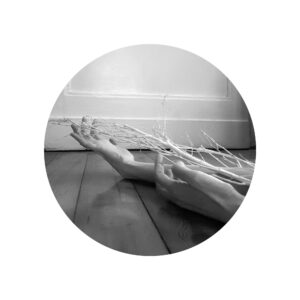
Eleonora Manca, Vedersi visti, 2019. Digital print. Courtesy the artist
In all of your works, language plays an important role: it is not simply a poetic element, but a deciphering of the movements staged, an allusion, a disturbing element, a mantra, or a revelation to be deciphered like the voice of a god who manifests through you. Are they fragments of ancient wisdom in contact with the contemporary? Are you that ancient soul who whispers to us something about our destiny?
I have always defined my age as millennial. But not out of affectation, on the contrary, there is a sort of melancholy in this. I have happy forays into the contemporary, but in the pockets of my coat I always keep something that belonged to other eras and of which I can barely stem the echo. I read, listen to words and see images. Every image creates words for me. Word and image have always been icons for me. The interpenetration is a harbinger of new languages or of an ancient language that returns to have a new voice, a new visual poetry. The only word I accept, especially in my works, is the poetic one. Thus, I find myself creating cut-ups by borrowing the verses of various poets. As with clothes, I cut, sew, unstitch, glue, neckline. This free version is also a poetic hybrid that is necessary for me. Because I always have this tendency to explore new possibilities, both linguistic and visual. Then I use this new vocabulary for my works. Sometimes I simply cut a poem and let an unpublished nucleus emerge. I leave written, spoken or whispered imprints. Other times I write the texts I will use myself.
Piero Deggiovanni
Info:
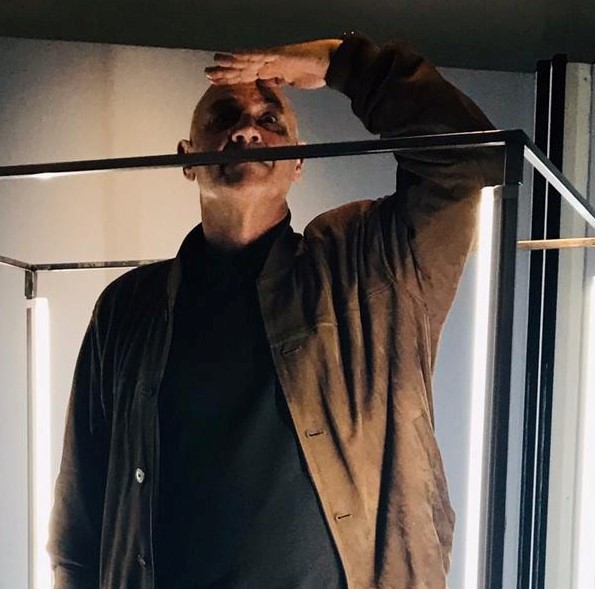
Piero Deggiovanni (Lugo, 1957) is a professor of History of Contemporary Art and History and Theory of New Media at the Academy of Fine Arts in Bologna and at LABA in Rimini. He is a critic and researcher in the field of contemporary art, member of the scientific committee of the Videoart Yearbook, Bologna University. For several years he has dedicated himself exclusively to research, focusing on video art and experimental cinema.






NO COMMENT